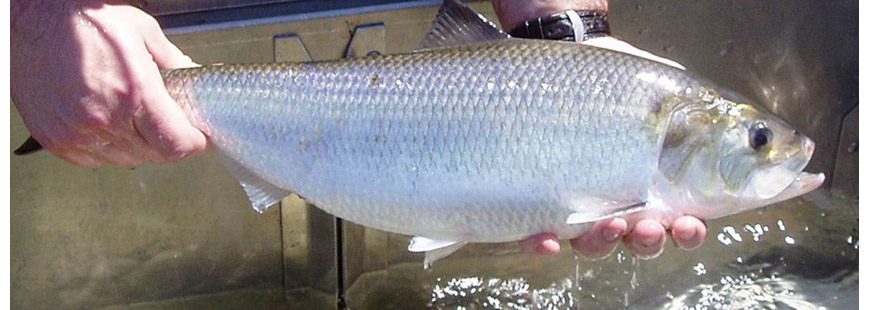ASMFC & USGS Announce Research Partnership
This article was originally published in The Wild Oceans Horizon newsletter and was reprinted with permission. View the latest issue and past issues of The Wild Oceans Horizon. Top image: shad, photo via the U.S. Fish and Wildlife Service.
The 2020 Atlantic States Marine Fisheries Commission (ASMFC) American shad stock assessment poses more questions than it answers. The coastwide metapopulation of this iconic fish (an abundant food source during colonial times harvested by George Washington himself) remains at all-time lows. Of the 23 stocks evaluated, stock status is unknown for 15 of them. Four major systems (the Connecticut, Hudson, Delaware, and Potomac Rivers) are either depleted or experiencing unsustainable levels of mortality. The causes are uncertain.
A new partnership between the ASMFC and the United States Geological Survey (USGS) Leetown Science Center in West Virginia aims to address critical information gaps. The Alosine Genetic Stock Identification and Tissue Repository Project, led by USGS Research Biologist Miluska Olivera-Hyde and Research Ecologist David Kazyak, will use genomic markers to build and expand baseline information for American shad as well as two depleted river herring species, alewife and blueback herring. (“Alosine” is a term used for the group of anadromous herrings that includes shad and river herring.) The result of their work will be a database representing fish from river systems throughout the Atlantic coast.
Shad and river herring spawn in their home river systems, and the young juveniles leave the river within their first year to spend the next 3-5 years at sea, joining with schools from other rivers. Although directed ocean fisheries for American shad have been prohibited since 2005, and there are no directed ocean fisheries for river herring, alosines are taken incidentally by fisheries targeting other species. Both the Mid-Atlantic and New England Fishery Management Councils have implemented shad and river herring bycatch caps for high-volume fisheries targeting Atlantic mackerel and Atlantic herring. However, the conservation efficacy of these caps remains uncertain because fishery mangers lack data about the individual shad and river herring populations comprising the bycatch.
Using genetic analyses to define stock structure and to determine the river system or regional origin of fish taken as bycatch is a high priority research need in the most recent American shad and river herring assessments. Ongoing studies have demonstrated that using genetic analyses to assign incidental catch to individual stocks can reveal which stocks are at greatest risk and can assist fishery managers in prioritizing conservation efforts. [I]
The ASMFC also plans to use the Alosine Repository for reviewing potential Endangered Species Act listings, evaluating stock enhancement programs and validating ageing of specimens.
The ecosystem benefits of restoring alosine stocks along the coast would be far-reaching. Shad and river herring are preyed upon by a wide array of fish, bird and mammal predators from riverine, estuarine and marine waters.
Many commercially and recreationally-important fish, from largemouth bass to striped bass, bluefish to bluefin tuna, depend upon shad and river herring to satisfy their dietary needs. Ospreys and bald eagles keep watch for running shad and river herring to feed their growing young. Shad and river herring also play a vital ecological role in the transfer of nutrients from ocean to inland ecosystems, enhancing aquatic vegetation at the base of the food web. [II]
River herring and shad runs once fueled local coastal economies, supporting recreational and commercial fisheries and driving tourism. Today, most in-river fisheries along the coast have closed because of the low numbers of fish returning to spawn.
If scientists succeed in meeting the project goals, the Alosine Genetic Stock Identification and Tissue Repository Project may provide long-awaited answers to community volunteers who wonder why fish are not returning from sea when they have labored for years to restore spawning habitat and natural stream flow, remove dams and other migration impediments and count returning fish.
With a clearer understanding of bycatch impacts, fishery managers can direct their attention to conserving the stocks most at risk, working in collaboration with coastal communities on efforts to bring back the bountiful river herring and shad runs that are a vital piece of our natural heritage.
Notes
[I] Palkovacs, E. P., D. J. Hasselman, E. E. Argo, S. R. Gephard, K. E. Limburg, D. M. Post, T. F. Schultz, and T. T. Willis. 2013. Combining genetic and demographic information to prioritize conservation efforts for anadromous alewife and blueback herring. Evolutionary Applications 7: 212-226.
[II] Mattocks, S., Hall, C. J., Jordaan, A. 2017. Damming, Lost Connectivity, and the Historical Role of Anadromous Fish in Freshwater Ecosystem Dynamics. BioScience, 67 (8), 713-728. doi: 10.1093/biosci/bix069.


